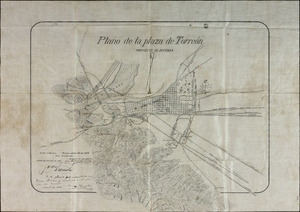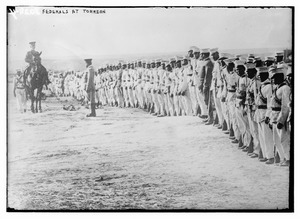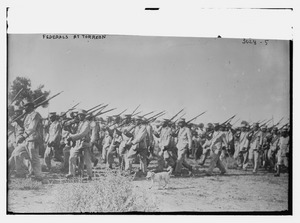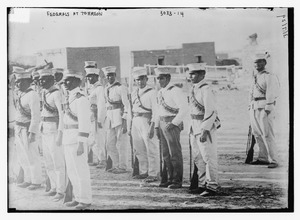Second Battle of Torreón facts for kids
Quick facts for kids Second Battle of Torreón |
|||||||
|---|---|---|---|---|---|---|---|
| Part of Mexican Revolution | |||||||
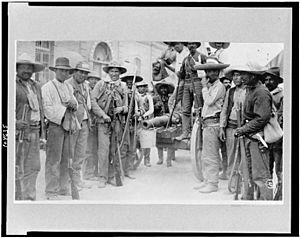 Mexican rebels with a cannon |
|||||||
|
|||||||
| Belligerents | |||||||
|
|
|
||||||
| Commanders and leaders | |||||||
| Strength | |||||||
| 18,000 men, with 34 pieces of artillery | 16,550 men, with 24 cannons | ||||||
| Casualties and losses | |||||||
| 1,500 | 8,000 | ||||||
The Second Battle of Torreón was a major fight during the Mexican Revolution. It took place from March 21 to April 2, 1914. In this battle, revolutionary forces led by Pancho Villa fought against government troops. The government forces were called Huertistas, after their leader, Victoriano Huerta. Villa's army successfully captured the city of Torreón.
Contents
Background of the Revolution
The Mexican Revolution started in 1910. It aimed to change how Mexico was governed. The first part of the revolution ended when President Porfirio Díaz left office in 1911. A new leader, Francisco I. Madero, took his place.
However, in early 1913, Madero was killed. Victoriano Huerta then became the new president. Many people did not like Huerta. They formed a group called the Constitutionalists to fight against him.
Pancho Villa was a key leader in this fight. He led the anti-Huerta movement in Chihuahua. Venustiano Carranza, the governor of Coahuila, was the overall leader of the uprising.
Villa's Growing Army
Pancho Villa started with only eight companions when he returned to Mexico from the United States. But over time, more and more people joined him. He also got more weapons. His forces had captured Torreón once before, in late 1913. But government troops took the city back while Villa was fighting elsewhere.
After another battle, Carranza wanted Villa to attack Torreón again. Villa needed more time to gather his forces. He also needed more money and weapons. He found a treasure worth 600,000 pesos. This money helped him buy many weapons, uniforms, and even an airplane. He also hired foreign pilots.
Villa created a special group of guards called the Dorados. They had new uniforms and modern rifles.
The revolutionaries also opened offices to recruit new soldiers. They put up posters, some in English, to attract people. Villa also hired American doctors for his hospital trains.
March to Torreón
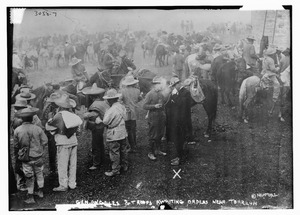
In mid-March, a skilled artillery expert named Felipe Ángeles joined Villa's army. On March 16, the army began its journey to Torreón. Thousands of soldiers traveled by train and on horseback. More people joined them along the way.
The trains carried horses, soldiers, and even makeshift kitchens. They also had 29 cannons and 1,700 grenades. A special reconnaissance train went first to check for dangers. Then came trains with repair materials, food, and 40 hospital cars.
Villa kept his movements secret. This surprised the government forces in Torreón. They thought Villa would stay in Chihuahua for a few more weeks.
The army reached Santa Rosalía de Camargo on March 17. They continued their journey, arriving at Conejos station on March 19. Villa ordered 12 water tankers because the area was very dry.
Villa's army grew to more than 8,000 soldiers. Key leaders included Maclovio Herrera, Eugenio Aguirre Benavides, and Toribio Ortega.
The government forces defending Torreón were led by José Refugio Velasco. He had about 7,000 men, 19 cannons, and 35 machine guns. Velasco placed troops in several locations around the city.
On March 20, Villa's army left Conejos. Some of his forces went to capture nearby towns. Tomás Urbina took Mapimí. Toribio Ortega defeated government troops at Estación Peronal and Bermejillo. Aguirre Benavides also won at Tlahualilo. The main part of Villa's army camped in Bermejillo.
Villa also sent troops to Sacramento. The government forces there fought hard. The battle lasted into the night, but the revolutionaries could not capture the town right away.
Battle for Gómez Palacio and Torreón
On March 22, Villa's main forces moved towards Gómez Palacio. This city was right next to Torreón. They used a special train with a large cannon called Niño. The train moved slowly, checking the tracks for bombs.
Meanwhile, the battle in Sacramento ended. Government soldiers surrendered and joined Villa's side. Their leader, Almazán, had to retreat to Torreón.
Villa's soldiers approached Gómez Palacio. They faced heavy cannon fire from the mountains. The revolutionaries attacked, reaching the city's edge. But government machine guns caused many casualties. Villa's forces managed to take the suburbs, but with many dead and injured.
On March 23, Felipe Ángeles placed cannons on a hill near Gómez Palacio. The main government base was on Cerro de la Pila. This hill was well-fortified with trenches and machine guns.
Villa planned to surround the enemy. He sent Herrera to capture Lerdo, southwest of Gómez Palacio. Villa himself helped defeat a government general named Federico Reina. The revolutionaries captured Lerdo that evening.
The Cerro de la Pila seemed impossible to capture. Villa's men launched eight attacks at night, but they were all pushed back. Their only airplane was useful for scouting, but its bombs did not work. On March 24, Aguirre Benavides returned with 4,000 men, making Villa's army much stronger. The day was spent resting and planning.
Ángeles believed the cannons needed to be closer to Torreón. So, Cerro de la Pila had to be taken. On March 25, a four-hour battle began. Villa's men attacked the hill, but it was very difficult. They had to cross an open area under enemy fire. They managed to take only two small forts on the mountain. Both sides suffered heavy losses that day.
The revolutionaries also cleared government forces between Gómez Palacio and Lerdo. More help arrived from Durango. On March 26, government forces counterattacked and took back the forts on La Pila. More of Villa's allies arrived, but they had little ammunition.
Later that day, the government forces unexpectedly left Gómez Palacio. They moved to Torreón, joining their main army. The exact reason for this is still not clear. It was likely a plan to wear down Villa's army before the main fight in Torreón.
Villa's troops entered Gómez Palacio. They began to loot the city until Villa arrived and restored order. The revolutionaries sent a message to Torreón, asking them to surrender. But the government commander, Velasco, refused. He expected more troops to arrive soon.
On March 28, government forces fired at the mountains around Torreón for eight hours. They did not achieve much. Villa's attack began at 10 p.m. His forces captured three positions at night. But one commander did not set up defenses, and the government forces took back two positions in a counterattack. Villa ordered the commander to be executed, but then gave his men a choice: either retake the positions or be shot.
Villa's forces continued to fight. They attacked different parts of the city. There was a brief ceasefire on March 30. Government leaders asked for 48 hours to collect the dead. But Villa refused, fearing the government would get reinforcements. So, the fighting continued. News came that more of Villa's allies were coming.
March 31 was quieter, with many soldiers resting. On April 1, government forces tried to break out of the city, but they were stopped. More of Villa's allies arrived, giving him a big advantage. Villa stopped the execution of the commander who lost positions earlier. He told his men to try and win them back.
Around 2 a.m. on April 2, Villa's forces recaptured some key positions. Two barracks in the city also fell to the revolutionaries. The government forces attacked Mount Santa Rosa, but it was defended.
This day was the bloodiest in two weeks of fighting. The government forces were running out of ammunition. They had only a small amount left. This made them decide to flee the city. At 4 p.m., their remaining 4,000 soldiers left Torreón. Villa's army was exhausted, so they did not chase them. They were glad to finally rest.
The revolutionaries had about 1,781 dead and 1,937 wounded. The government forces had about 8,000 dead, injured, or captured. Villa's forces treated the 400 seriously injured government soldiers left behind. Fewer captive officers were shot compared to earlier battles.
A film company tried to film the battle. Some of the footage was ruined and had to be refilmed later. There is a story that Villa delayed an attack for the filmmakers, but this is likely not true.
Aftermath
On April 3, Villa arrived in Torreón. He was greeted like a hero. Villa issued a decree forbidding alcohol consumption. He also ordered everyone to clean their houses and streets.
Villa also arrested most of the Spanish people in the city. He believed they supported Huerta and paid their workers very low wages. He sent them towards the northern border. Two months later, he released those who did not support the government. He admitted there were some unfair actions, but said it happened during wartime.
The battle caused a lot of damage to the city. But Villa found a lot of cotton. He sold it and used the money to buy food and supplies for the people of Torreón. He also taxed new businesses in the city.
After Torreón, another big battle happened. Villa's forces fought the government army in San Pedro de las Colonias. Villa's 12,000-16,000 revolutionaries defeated the government forces on April 14. The remaining government soldiers fled.
Images for kids
See also
 In Spanish: Batalla de Torreón para niños
In Spanish: Batalla de Torreón para niños


